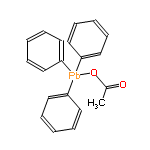-
Name
LEAD TRIPHENYL ACETATE
- EINECS
- CAS No. 1162-06-7
- Article Data5
- CAS DataBase
- Density g/cm3
- Solubility
- Melting Point 206.5°C
- Formula C20H18 O2 Pb
- Boiling Point °Cat760mmHg
- Molecular Weight 497.562
- Flash Point °C
- Transport Information
- Appearance
- Safety Poison by ingestion, intravenous, and intraperitoneal routes. When heated to decomposition it emits toxic fumes of Pb. See also LEAD COMPOUNDS.
- Risk Codes R61; R20/22; R33; R50/53; R62
-
Molecular Structure
- Hazard Symbols
- Synonyms Lead,acetoxytriphenyl- (7CI); Plumbane, (acetyloxy)triphenyl- (9CI); Plumbane,acetoxytriphenyl- (8CI); Acetatotriphenyllead; Acetoxytriphenyllead;Acetoxytriphenylplumbane; NSC 88644; Triphenylacetoxylead; Triphenylleadacetate
- PSA 26.30000
- LogP 4.09340
Triphenyllead acetate Chemical Properties
IUPAC Name: Triphenylplumbyl acetate
Molecular Formula: C20H18O2Pb
Molecular Weight: 497.57 g/mol
EINECS: 214-601-2
Melting Point: 206–207°C
Boiling Point: 461.5 °C at 760 mmHg
Flash Point: 232.9 °C
Properties: crystals from EtOH.
Freely Rotating Bonds: 5
Polar Surface Area: 26.3 Å2
Enthalpy of Vaporization: 72.23 kJ/mol
Vapour Pressure: 1.07E-08 mmHg at 25 °C
The Cas Register Number of Triphenyllead acetate is 1162-06-7.The chemical synonyms of Triphenyllead acetate (CAS NO.1162-06-7) are Acetoxytriphenyllead ; Acetoxytriphenylplumbane ; Caswell No. 896B ; Plumbane, acetoxytriphenyl- ; Triphenyllead acetate (ACN) ; (Acetyloxy)triphenylplumbane ; Triphenylplumbyl acetate ; Plumbane, (acetyloxy)triphenyl- ;
Lead triphenyl acetate .The molecular structure of Triphenyllead acetate (CAS NO.1162-06-7) is .
.
Triphenyllead acetate Toxicity Data With Reference
| 1. | orl-rat LD50:200 mg/kg | BIJOAK Biochemical Journal. 127 (1972),24P. | ||
| 2. | ipr-rat LD50:2800 µg/kg | JJATDK JAT, Journal of Applied Toxicology. 1 (1981),247. | ||
| 3. | ivn-rat LD50:5 mg/kg | JJATDK JAT, Journal of Applied Toxicology. 1 (1981),247. |
Triphenyllead acetate Consensus Reports
Lead and its compounds are on the Community Right-To-Know List.
Triphenyllead acetate Safety Profile
Poison by ingestion, intravenous, and intraperitoneal routes. When heated to decomposition it emits toxic fumes of Pb. See also LEAD COMPOUNDS.
Hazard Codes:  T,
T, N
N
Risk Statements: 61-20/22-33-50/53-62
R20/22: Harmful by inhalation and if swallowed.
R33: Danger of cumulative effects.
R50/53: Very toxic to aquatic organisms, may cause long-term adverse effects in the aquatic environment.
R61: May cause harm to the unborn child.
R62: Risk of impaired fertility.
Safety Statements: 53-45-60-61
S45: In case of accident or if you feel unwell, seek medical advice immediately (show the label whenever possible.)
S53: Avoid exposure - obtain special instructions before use.
S60: This material and its container must be disposed of as hazardous waste.
S61: Avoid release to the environment. Refer to special instructions / safety data sheets.
About|Contact|Cas|Product Name|Molecular|Country|Encyclopedia
Message|New Cas|MSDS|Service|Advertisement|CAS DataBase|Article Data|Manufacturers | Chemical Catalog
©2008 LookChem.com,License: ICP
NO.:Zhejiang16009103
complaints:service@lookchem.com Desktop View